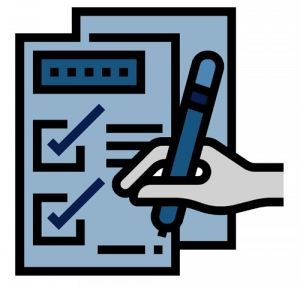Report Organization
Reports vary by size, format, and function. You need to be flexible and adjust your report to the needs of the audience. Reports are typically organized around six key elements:
- Who the report is about and/or prepared for
- What was done, what problems were addressed, and the results, including conclusions and/or recommendations
- Where the subject studied occurred
- When the subject studied occurred
- Why the report was written (function), including under what authority, for what reason, or by whose request
- How the subject operated, functioned, or was used
Pay attention to these essential elements when you consider your stakeholders. That may include the person(s) the report is about, whom it is for, and the larger audience of the organization. Ask yourself who the key decision makers are, who the experts will be, and how your words and images may be interpreted. While there is no universal format for a report, there is a common order to the information. Each element supports the main purpose or function, playing an important role in the transmission of information. Some common elements in a report are shown in Table 9.3.1.
Table 9.3..1 Parts of a Report
| Page |
Description |
| Title Page |
- Report title; date of submission; name, title, and organization of the person who prepared the report; name, title, and organization of the person receiving the report.
- If your report contains sensitive information or if it is going to be exposed to the elements, it might also contain a cover page.
- No page number.
|
| Table of Contents |
- A list of the sections in the report and their respective page numbers.
- All headings/sub-headings in the report should be listed on this page.
- This page is not labelled with a page number.
|
| Executive Summary |
- The executive summary is a one-page overview of the entire report aimed at managers or people in a position of power. It discusses the managerial implications of your report: basically what managers or other people who have the authority to approve your report need to know. Summarize the topic, methods, data/evidence, results, and conclusions/recommendations.
- On its own page.
- Labelled as page iii.
|
| Introduction |
- Introduces the topic of the report, states the purpose of the report, and previews the structure of the report. This section often contains similar information to the Executive Summary, but in a clear, factual manner. It may spend more time discussing the purpose, scope, and methods used, and offer just a brief outline of the conclusion reached.
- Begins on a new page.
- Labelled as page 1.
|
| Body |
- Key elements of the report body may include the background, methods, results, and analysis or discussion.
- Uses descriptive or functional headings and sub-headings (is not labelled “Body”).
- Pagination continues from the introduction.
|
| Conclusion and/or Recommendations |
- Concise summary of findings; detailed recommendations (for recommendation reports). Indicate the main results and their relation to the recommended action(s) or outcome(s).
- Pagination continues from the body of the report.
|
| References |
- A list of all references used in the report.
- All in-text citations included in the report should have an accompanying entry in the reference list.
- Begins on a new page.
- Pagination continues from the conclusions and/or recommendations.
|
Appendix or Appendices (if needed)
|
- Related supporting materials.
- All materials in the appendix (or appendices) must be referred to in the body of the report.
- Only one item per appendix.
- Each appendix begins on a new page, is labelled as Appendix A, B, C, etc, and is given a title.
- Pagination continues from the reference list.
|
Here is a checklist for ensuring that a report fulfills its goals:
 Report considers the audience’s needs
Report considers the audience’s needs- Form follows function of report
- Format reflects institutional norms and expectations
- Information is accurate, complete, and documented
- Information is easy to read
- Terms are clearly defined
- Figures, tables, and art support written content
- Figures, tables, and art are clear and correctly labelled
- Figures, tables, and art are easily understood without text support
- Words are easy to read (font, arrangement, organization)
- Results are clear and concise
- Recommendations are reasonable and well-supported
- Report represents your best effort
- Report speaks for itself without your clarification or explanation
 Report considers the audience’s needs
Report considers the audience’s needs
